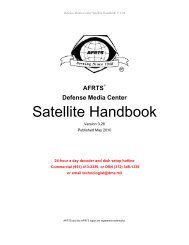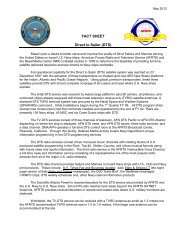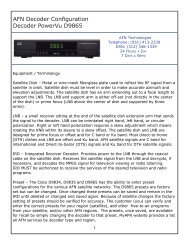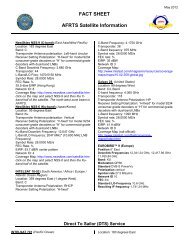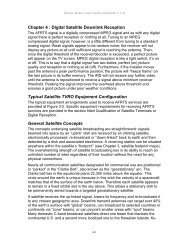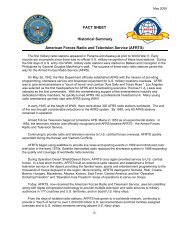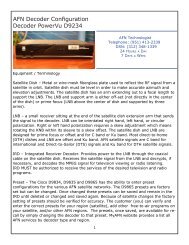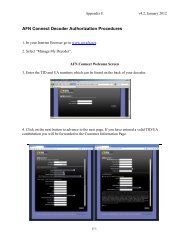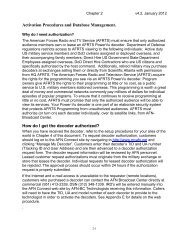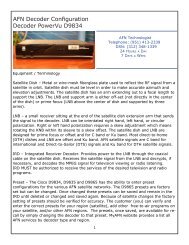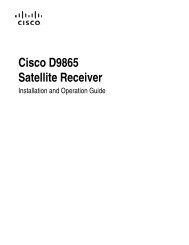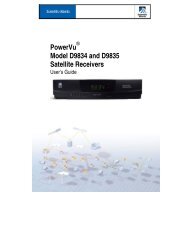AFRTS Defense Media Center Satellite Handbook
AFRTS Defense Media Center Satellite Handbook
AFRTS Defense Media Center Satellite Handbook
You also want an ePaper? Increase the reach of your titles
YUMPU automatically turns print PDFs into web optimized ePapers that Google loves.
<strong>Defense</strong> <strong>Media</strong> <strong>Center</strong> <strong>Satellite</strong> <strong>Handbook</strong> V.3.26<br />
receiving antenna into a “clear” path. Should the presence of these carriers be<br />
detected prior to site location, they can be treated as part of the satellite link<br />
analysis to evaluate their affect on performance.<br />
Impulse and Ignition Noise<br />
A digitally compressed video signal can be susceptible to interference from<br />
impulse generators. Some typical sources of impulse noise are power equipment<br />
(power generators) or ignition noise from engines (vehicles, motorcycles,<br />
mopeds, lawn mowers, power blowers). Spark emissions cover a wide band of<br />
RF frequencies including C-band and can enter through the satellite dish and<br />
LNB. These emissions can originate from engines where broken, intermittent or<br />
“arcing” spark plug cables are used. Ignition wires are typically resistive wires<br />
that dampen RF radiation, however a broken or intermittent ignition wires can arc<br />
and emit excessive radio interference. Ignition “burst noise” can last in excess of<br />
1 millisecond, exceeding the interleave depth of the error correction system<br />
designed into the IRD and can have a power level 40 dB higher than the satellite<br />
carrier. The repetition rates greater than once every 70 millisecond have been<br />
detected.<br />
When planning an earth station you should site the station well away from<br />
sources of ignition interference such as busy roads, highways, intersections, or<br />
car parks. You may want to restrict the use of gasoline-powered lawn mowers<br />
and other combustion engines during peak usage hours.<br />
Because ignition noise represents broadband interference an operator<br />
experiencing ignition noise should address both the issue of saturation as well as<br />
attempt to reduce the magnitude of the interfering source. To address saturation,<br />
attenuators should be utilized both at C-band (if used) and L-band. An interfering<br />
carrier from a automobile ignition can be more than 40 dB higher than the<br />
receiving signal and saturate LNB’s, line amplifiers and the RF tuner in the<br />
satellite receiver. Severe ignition noise problems can be addressed by relocation<br />
of the receiving antenna, use of an “earth berms”, or installation of an RFI<br />
grounded fence between the interfering sources and the earth station antenna.<br />
Aircraft Radar Altimeters/Airport Ground Radar<br />
If your downlink antenna is located near an airport or flight path your system can<br />
pick up interfering carriers from aircraft radar altimeters. The radar altimeter<br />
Spectrum is 4.200 to 4.400 GHz. This corresponds to 750 to 950 MHz at the Lband<br />
output of the LNB. These carriers have been measured in excess of<br />
+40dBc relative to the desired satellite carrier. This kind of interference often<br />
results in the saturation of any line amplifiers to the extent that the amplitude of<br />
the desired Spectrum is reduced below a measurable level. The effects of this<br />
interference may last several seconds until the aircraft passes out of the earth<br />
station antenna beam. The interference appears as a chirp or energy spread<br />
over the indicated Spectrum. It is first observed as a low level signal and<br />
gradually builds to its maximum level before gradually diminishing.<br />
4-15



